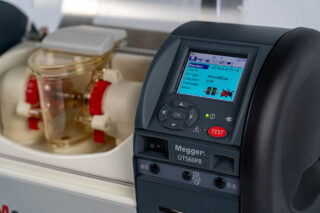Based in Toulouse, the innovative French startup AURA AERO is revolutionizing aviation with its cutting-edge low-carbon aircraft. With ambitions to dominate the regional transport sector—much like Tesla did with electric vehicles—AURA AERO has already secured over 500 purchase commitments. In an exclusive interview, DirectIndustry sat down with key executives David Roche and Jacques Rocca to uncover the bold strategy driving this game-changing company.
Will AURA AERO be the Tesla of the skies? In any case, the company certainly has that ambition. Founded in 2018, the French startup, with 250 employees, and which we previously met at the Paris Air Show in 2023 (read our article), is developing two types of low-carbon aircraft.
One of them, INTEGRAL, is a two-seater plane with a fuselage made of wood and carbon fiber. It is designed to train the pilots of tomorrow—about 600,000, according to the company. Equipped with a ballistic parachute, it comes in both thermal and electric engine versions. The first flight is scheduled for a few days from now in Toulouse. Certification is expected by the end of the year.
The other, ERA (Electric Regional Aircraft), is a hybrid electric plane with up to 19 seats. It was fully designed digitally using PTC’s digital simulation tool OnShape.
DirectIndustry spoke with Jacques Rocca, Head of Communications, and David Roche, Deputy Director of Digital Services, to learn more about ERA. We discussed how digital tools enabled its development at a competitive price and how AURA AERO aims to become the Tesla of aviation.

ERA: The Aircraft Designed for Regional Transport
The ERA is not yet built. But with its future hybrid electric propulsion system, this 19-seater is expected to revolutionize low-carbon regional aviation, explains Jacques Rocca:
“This new, highly innovative avionics will allow the pilot to manage the energy resources—the batteries, the turbo generators that will provide him with synthetic fuel or extra energy he needs to extend his route or increase engine thrust.”
The development of this 19-seater stems from the need to renew a fleet of regional aircraft in a low-carbon version. These planes typically fly between 300 and 600 nautical miles.
“Over 5,000 planes need to be replaced in the short term in regional transport. These are often planes nearly 50 years old, very polluting, and requiring a lot of maintenance, both in terms of the airframe and the engine. Offering a new plane, with new avionics and a new design, is a real added value compared to the products currently in service. That’s the market for which we designed the ERA program.”
Besides, a large part of aviation’s carbon footprint comes from these shorter flights. This new type of aircraft could thus help decarbonize regional aviation. And according to Jacques Rocca, this can happen very quickly:
“Technical solutions are within the reach of manufacturers to make operational low-carbon planes before 2030. Low-carbon aviation to replace Boeing or Airbus planes carrying 300 people across the Atlantic will come later because the technical solutions do not yet exist. But for regional aviation, they do. We can do it, and quickly.”
Another advantage is that this type of aircraft could open new regional routes, reconnecting medium-sized cities with each other.
New Design
According to the European Aviation Agency, a 19-seater plane belongs to the CS-23 category. And Jacques believes that AURA AERO has every chance of becoming a leader in this sector because very few manufacturers are positioned in this category. Airbus is not. ATR targets the higher CS-25 category (40 to 100 passengers).
“Many new companies in the aviation sector are moving toward decarbonization. But the vast majority of them offer short-distance transport solutions like eVTOLs. We’re not in that category. There are very few manufacturers offering low-carbon energy solutions for regional transport and for a plane of this size. We’re in a niche, but the market is sending us very positive signals,” Jacques says enthusiastically.


Pre-Orders and Commercialization
Even before having a flying prototype, AURA AERO already has 570 pre-orders for the ERA, representing an order book value of nearly $9 billion. More than half of the purchase intents come from the United States.
The ERA’s interior design is available in four versions, depending on client needs. The basic model can carry 19 passengers with a crew of two. This is the choice of the airline TwinJet, for example, for flights like Toulouse-Marseille. By reducing the number of seats to eight more comfortable, wider seats and adding work tables, the ERA becomes a business jet. Gabonese and Maltese clients have made this choice, for example. The plane can also be used for cargo, as the rear of the fuselage is equipped with a cargo door. This is the intention of the American company Alpine Express, which pre-ordered 75 units last July. AURA AERO is also in discussions with defense players, as the military may find this aircraft appealing due to its hyper-quiet, and thus discreet, electric propulsion system.
The ERA’s first prototype flight is scheduled for 2026, followed by a two-year test campaign, with certification in 2028 or early 2029, and commercial service before 2030.
Digitalization
AURA AERO could have chosen to be a demonstrator, like other companies in the aerospace sector. This is the case with Daher, for example. The leader of the EcoPulse project is working to develop the key architectural principles of tomorrow’s hybrid planes by integrating various existing technologies. But AURA AERO took a different path, as Jacques explains:
“For us, to have an aircraft as operational as possible, with the lowest operating costs possible, it’s about designing it from scratch, from a blank sheet. Because we can bring in new materials, new avionics technologies, and better integration. And we’ll have an aircraft with significantly reduced operating costs, which is what operators are interested in.”
This is why AURA AERO turned to digitalization. ERA was entirely digitally designed from the start, explains David Roche, Deputy Director of the company’s Digital Services:
“This is where the parallel with Tesla comes in. From the outset, we aimed to center the company around data, leveraging our data to understand it, use it for learning, and continuously improve. We developed a data platform that ensures all our solutions’ data is collected, interconnected, and fully utilized. Being digital-native means having systems that can seamlessly communicate with each other within our architectural framework. As a small company, we believe it’s essential to have robust capabilities to operate a cyber-secure infrastructure. Additionally, given our anticipated growth, it doesn’t make sense to centralize everything in one location and buy and maintain servers which cost a lot of money. That’s why we opted for a full SaaS approach. When we searched for tools to design the plane, cloud-native platform OnShape emerged as the best choice, as it fulfilled our need for interconnectivity and was natively SaaS.”
With Onshape by PTC, AURA AERO teams can collaborate in real time on their 3D CAD models and share them instantly with their partners.

No More Paper
One of the biggest advantages of Onshape was eliminating paper and plans. For example, an aircraft mechanic can instantly consult the latest designs from the workshop without having to refer to paper drawings. They have immediate access to the most up-to-date data and modifications.
As a result, AURA AERO is the first aerospace manufacturer to achieve a fully digital, paperless design certification. The 3D OnShape design serves as the official blueprint for aircraft production, saving the team time and money.
According to Jacques, digital simulation also has an advantage for testing avionics.
“Pilots must manage energy while flying—this is called Energy Management Planning (EMP). It involves the ability to oversee the entire operation of the aircraft over its daily or multi-day cycles to say, for example, ‘I’m going to this airport, there’s electric charging available or not, I have this much distance to cover, and after that, I have another flight…’ This is new, and the real value lies in simulating and preparing it in advance.”
Nicolas says AURA AERO also uses another PTC PLM, Arena, especially for encapsulating the design process within a broader modification management process.
“Aviation regulations are very strict. We must ensure full traceability, from the initial requests to the fabrication and installation of equipment on the aircraft, to verify that everything requested has been properly executed. This applies to managing modifications on the aircraft, including the approval process for changes, the design workflow, and subsequent production approval. This ensures traceability, validates certifications and also helps us understand the rationale behind specific design decisions. Our engineers can trace everything back to the initial requests. Each modification, instantly saved, is accessible to all team members. For the ERA project, we ran hundreds of digital tests on various design and architectural choices, systematically eliminating options while ensuring we could track the entire history—from what we intended to do to what we ultimately achieved. “
Partnerships and Growth Objectives
AURA AERO can now count on three major partners for its ERA program. Safran for the engines, Thales for the avionics, and Airbus for the CS-23 certification process. These three partners are also keen to learn from the project’s feedback for their own developments, Jacques explains:
“For example, the avionics suite offered by Thales is inspired by what they do in helicopters, but it’s a novelty to put it in a 19-seater plane. Airbus, on the other hand, has a hydrogen aircraft project, and they’re interested in following our CS-23 certification process because they will face the same situation when certifying their hydrogen propulsion prototypes.”
AURA AERO will start building its production plant in Toulouse by the end of next year. Operations are set to begin in 2027. The factory will have the capacity to produce up to 150 aircraft per year, including 100 ERA and 50 INTEGRAL.
This factory is designed to be replicable, depending on market growth. AURA AERO is already in discussions with the state of Florida in the U.S. A local branch of the company will open by the end of the year with an on-site team to lay the groundwork.
AURA AERO is also looking at the Middle East and Asia-Pacific, although they did not provide further details on future partnerships. However, discussions have already begun with Fiji.











